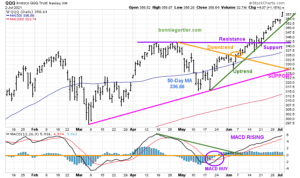For those who are newcomers to the investment and financial world there are certain words or phrases that can appear to be difficult to grasp but let me assure you as you become more familiar with how money works they are easier to understand.
I’ve compiled this list of definitions for you to easily reference as certain terms appear in Barrons and other financial publications. This is not a complete list as of yet, and I will add more as needed. This list is meant to help you better understand the concepts behind how your money can work for you as you become more knowledgeable within the financial game. You can also send me any words or phrases that you may need further clarity on and I will respond in easy to understand language and include them on this list, as well. It is my mission to help everyone understand more about money and how you can make it work for you. Make sure to check out a couple of my previous posts on the Money Page of my blog to help you get started. There are more on the way! Create an excellent week! ~Bonnie
In the Market Week Section the following categories exist:
1. The Trader is a column which summarizes what has occurredduring the week, performance statistics for the individual investor, advisor, and the technical guru type in an easy to read table. More information will be charts of major market indices, which include The Dow Industrials, S&P500, and the Nasdaq Composite, that contain the vital signs of the weeks that tell the story, whether it was a profitable or a losing week.
2. International Trader includes articles on foreign investment in Asia and Europe which will summarize some key points of interest of what occurred globally.
3. Current Yield has the bond center that includes charts and information on bonds that are most active for the week with their prices, maturity, and yield. This is a useful overview to see quickly if rates are rising or falling which is good to know when you are investing in the stock market.
4. Commodities Corner has article about commodities like gold, lumber, and oil as examples along with articles including stories on futures, stocks, and Exchange Traded Funds as examples. This section is for the more advanced trader.
5. The Striking Price gives information about equity options which includes graphs, the week’s most active stocks that trade options as not all do. You will also find the symbol, price, and volume in an easy to read table format for quick viewing purposes.
Key terms
Exchange-Traded Portfolios (Fund) – A security that tracks an index, a commodity or a basket of assets like an index fund, but trades like a stock on an exchange. ETF’s experience price changes throughout the day as they are bought and sold. Because it trades like a stock, an ETF does not have its net asset value (NAV) calculated every day like a mutual fund does. By owning an ETF, you get the diversification of an index fund as well as the ability to sell short, buy on margin and purchase as little as one share. Another advantage is that the expense ratios for most ETF’s are lower than those of the average mutual fund.
The Barron’s has a complete section of Exchange-Traded Portfolios which include name, the symbol, 52 week high/low, volume, and weeks change.
Mutual funds – An investment vehicle that is made up of a collection of funds comprised from many investors for the purpose of investing in securities such as stocks, bonds, money market instruments and similar assets. Mutual funds are operated by money mangers, who invest the fund’s capital and attempt to produce capital gains and income for the fund’s investors. A mutual fund’s portfolio is structured and maintained to match the investment objectives stated in its prospectus. In the Barron’s there is a list of the top 2500 mutual funds by asset size.
The table includes the closing price, performance for the week, year to date, and three year performance. Before you invest your money in a mutual fund it’s a good practice to call and verify all information that you read in any newspaper article, internet site or from a friend. As in all the things we do, checking our work by taking an extra few minutes to verify, can save us time, aggravation, and in the end can save you money.
Bonds – A bond is a loan, commonly referred to as fixed-income securities. A debt investment in which an investor loans money to an entity (corporate or governmental) that borrows the funds for a defined period of time at a fixed interest rate. Bonds are used by companies, municipalities, states and U.S. and foreign governments to finance a variety of projects and activities.
The indebted entity (issuer) issues a bond that states the interest rate (coupon) that will be paid and when the loaned funds (bond principal) are to be returned (maturity date). Interest on bonds is usually paid every six months (semi-annually). The main categories of bonds are corporate bonds, municipal bonds, and U.S. Treasury bonds, notes and bills, which are collectively referred to as simply “Treasuries”.
Two features of a bond – credit quality and duration – are the principal determinants of a bond’s interest rate. Bond maturities range from a 90-day Treasury bill to a 30-year government bond. Corporate and municipals are typically in the three to 10-year range.
You will find in the Barron’s weekly bond statistics that will give you estimates on yields that are available for various different types of bonds. Some examples are corporate bonds, hi yield bonds, Tips (Inflation-Indexed Treasury Securities, US Notes and Bonds, and other Agency Securities. There is also a large listing where you can find out how much T bills (risk free investments) are paying for the short and long term.
Options – a type of investment that comes from an underlying asset. An option gives its holder the right, but not the obligation, to buy (call option) or to sell (put option) some underlying asset on or before the option’s expiration date, at an agreed on price (the strike price). One options contract represents one hundred shares in the underlying stock. The quoted price of an option is per share. The quoted price of a stock option must be multiplied by 100 to get the cost per contract. Some commonly used options are stock, commodity, bond options which include interest rate options, stock market index options and options on futures contracts. A small section is carried in the Barron’s newspaper but the full listing of what stocks and indices can be found free online at www.barrons.com/data.
Stocks -They are a type of security that signifies ownership in a corporation and represents a claim on part of the corporation’s assets and earnings.
There are two main types of stock: common and preferred. Common stock usually entitles the owner to vote at shareholders’ meetings and to receive dividends. Preferred stock generally does not have voting rights, but has a higher claim on assets and earnings than the common shares. For example, owners of preferred stock receive dividends before common shareholders and have priority in the event that a company goes bankrupt and is liquidated.
Commodities – are raw materials, agricultural and other primary products that trade on specialized exchanges. Commodities can be considered risky investments and many times they do not move in the direction of the overall market.
Closed End Funds A closed-end fund is a publicly traded investment company that raises a fixed amount of capital through an initial public offering (IPO). The fund is then structured, listed and traded like a stock on a stock exchange.
Despite the name similarities, a closed-end fund has little in common with a conventional mutual fund, which is technically known as an open-end fund.
The former raises a prescribed amount of capital only once through an IPO by issuing a fixed amount of shares, which are purchased by investors in the closed-end fund as stock. Unlike regular stocks, closed-end fund stock represents an interest in a specialized portfolio of securities that is actively managed by an investment advisor and which typically concentrates on a specific industry, geographic market, or sector. The stock prices of a closed-end fund fluctuate according to market forces (supply and demand) as well as the changing values of the securities in the fund’s holdings.
These are mutual funds professionally managed by an investment company with a finite number of shares issued. There must be a buyer for every seller and no additional shares are created like an exchange traded fund. Investors purchase them for their high dividend payout, however many can be leveraged and are risky investments so you need to do research to know what you are actually investing in.
Resource: http://www.investopedia.com/dictionary/
To discover how to achieve your financial dreams click here
Visit www.BGJourneyToWealth.com for more insights to growing your wealth!

Bonnie Gortler (@optiongirl) is a successful stock market guru who is passionate about teaching others about social media, weight loss and wealth. Over her 30-year corporate career, she has been instrumental in managing multi-million dollar client portfolios within a top rated investment firm. Bonnie is a uniquely multi-talented woman who believes that honesty, loyalty and perseverance are the keys to success. You will constantly find her displaying these beliefs due to her winning spirit and ‘You Can Do It’ attitude. Bonnie is a huge sports fan that has successfully lost over 70 pounds by applying the many lessons learned through her ongoing commitment toward personal growth and development while continually encouraging others to reach their goals & dreams. It is within her latest book project, “Journey to Wealth”, where Bonnie has made it her mission to help everyone learn the steps needed to gain sustainable wealth and personal prosperity. Order your copy of ”Journey to Wealth” today!
- Subscribe to BonnieGortler.com
- Connect with Bonnie via LinkedIn, Twitter & Facebook
- Put a smile on someone’s face and Send a card on Bonnie!
- Choose your very own FREE down-loadable gift by visiting bit.ly/bgoffers
Like this post? Feel free to use it in your blog or ezine as long as you use the above signature in its entirety












